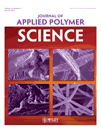Toughness enhancement of poly(lactic acid) by melt blending with natural rubber
Abstract
Rubber toughened poly(lactic acid) (PLA) was prepared by blending with natural rubber (NR)-based polymers. The blends contained 10 wt % of rubber and melt blended with a twin screw extruder. Enhancement of impact strength of PLA was primarily concernced. This study was focused on the effect of rubber polarity, rubber viscosity and molecular weight on mechanical properties of the blends. Three types of rubbers were used: NR, epoxidized natural rubber (ENR25 and ENR50), and natural rubber grafted with poly(methyl methacrylate) (NR-g-PMMA). Effect of viscosity and molecular weight of NR, rubber mastication with a two-roll mill was investigated. It was found that all blends showed higher impact strength than PLA and NR became the best toughening agent. Viscosity and molecular weight of NR decreased with increasing number of mastication. Impact strength of PLA/NR blends increased after applying NR mastication due to appropriate particle size. DMTA and DSC characterization were determined as well. © 2011 Wiley Periodicals, Inc. J Appl Polym Sci, 2011




